Human Resources Recruitment Policy Sample Template
1.OBJECTIVE
The objective of this policy is to articulate the process, roles and responsibilities of the various stakeholders involved in the recruitment process and help to achieve the organization's objectives through recruitment of competent employees. [Company Name] is an equal opportunity employer and is committed towards creating a healthy working environment. We do not discriminate based on race, color, religion, nationality, gender, differently abled or age.
2. DEFINITIONS
•External Applicant is referred to as an individual who is not a current employee in the organization and has applied to an open position or has submitted his/her application in anticipation of an open position at the company.
•Internal Applicant is an existing employee of [Company Name] who has after due approvals applied for an internal job posting.
•Manpower Requisition Form (MRF) refers to a form that is submitted with all mandatory details by the line/reporting manager or head of department to HR, for an open position.
•Candidate Application Form (CAF) refers to the pre-requisite document required for releasing an offer with details of the candidate & salary.
3. POLICY GUIDELINES
3.1. Manpower Planning
3.1.1. Staffing forecast should be done in order to have a foresight of the manpower status and allocation for concerned department.
3.1.2. Manpower Plan for the year, prepared and submitted to the HR, shall comply with the staffing budget requirements.
3.1.3. HR department will follow up with the Operations Heads for the annual staffing requirements.
3.1.4. Operation Heads for the annual staffing requirement.
3.1.5. The Manpower plan for the next year will be prepared by the Operation Heads in consultation with the HR during the annual budget meeting, to be held in the month of November/December
3.1.6. HR will initiate the recruitment and deployment of newly hired employees to man the departments as per the manpower plan.
3.1.7. Each department shall have an approved yearly staffing budget.
3.1.8. Any additional requirements for staffing shall be subject to the approval of the management.
3.1.9. Any deviation or mid-year requests for additional manpower will require approval from the management.
3.2. Candidate recruitment process summary
The steps of the recruitment process are as follows:
3.2.1. A Manpower Requisition Form (MRF) is completed and authorizations sought for both, budgeted and no budgeted positions.
3.2.2.The Job Description (JO) for the role is created by the recruiter/ HR manager in consultation with the hiring manager. In case of hiring for a similar position, a previously approved job description may be used.
3.2.3. External job posting - The positions may also be advertised through both online and offline methods. The recruitment team ensures that only approved job descriptions are shared in the job postings. Based on business needs, position details may be shared with recruitment vendors empaneled with the organization.
3.2.4. Relative Declaration - The recruitment team takes a declaration from the candidates of the relatives employed in [Company Name].
3.2.5. Candidate Assessment:
• Psychometric assessments may be conducted for all positions (based on business requirement), with the approval of the CEO.
• Interviews for the various positions are conducted as per the panel assessment guidelines. The recruitment team ensures that the Interview Assessment form is filled by all relevant panel members.
3.2.6. Reference and background checks should be conducted internally for all candidates prior to selection. For Directors & above, it should be compulsorily done through third party.
3.2.7. Candidate Compensation: The recruiter collects the current compensation and benefits details and expected compensation details from the candidate and send it along with the interview notes and approved MRF to the Recruitment Manager, who will facilitate the discussion between the hiring managers and Function Head/ HR Head / CFO/ CEO on the compensation to be offered, and inform the candidate accordingly.
3.2.8. Offer Letter: Post selection of the candidate, the recruiter communicates the decided offer verbally to the candidate, followed by a formal offer letter. The recruitment team initiates the offer processing and keeps the head of department informed of this. The recruiter ensures that the candidate reverts with an offer acceptance within seven (7) working days.
3.2.9. Rejected Candidates are respectfully contacted and sent a candidate rejection letter/email. The recruiters store resumes of potential hires for future use.
3.2.10. In case, some additional steps (like medical test etc.) are required to be carried out, as per the local country law, the recruitment team ensures that these are adhered to.
3.2.11. A candidate cannot apply within 6 months, if rejected.
3.3.Sourcing applicants
3.3.1. Internal Job Posting (IJP) Guideline
• All open positions are suitably advertised internally so that existing employees may apply within the scope of the Internal Job Posting (IJP) procedure.
• All employees are eligible to apply for an IJP based on the following criteria:
3.3.1..1. Applicant has completed minimum one (1) year of continuous service in the organization. In case, one (1) completed appraisal is not available, the documented performance feedback is to be taken from the HR.
3.3.1..2. Applicant is at an equivalent or one sub-band below the position applying for.
3.3.1..3. Applicant has at least obtained rating of '3 or higher' during the last performance appraisal cycle.
3.3.1..4. Applicant has not had any disciplinary action initiated against him/her in the last performance year. If any disciplinary action has been taken, the recommendation is reviewed by the Committee.
• Post application to the IJP, the employee is to formally inform the HR and the current reporting manager.
• The current reporting manager takes the internal transfer as a positive career move, if the employee meets all the above criteria and helps facilitate a smooth transition. The procedure for the IJP is as follows:
3.3.1..1. Shortlisted applicants undergo interview and selection process by the hiring manager/panel. Reference to previous performance records and manager's feedback may be considered for final selection.
3.3.1..2. The unit HR in consultation with the compensations team determine applicable grade/salary, considering internal equity and external parity guidelines. The selected applicant is absorbed for the position once conditions of the offer are agreed upon.
3.3.1..3. A successful selection does not necessarily mean a change in the compensation until necessitated to match internal equity or skill level.
3.3.1..4. The exact joining date are decided in consultation with the HR and current reporting manager.
3.3.1..5. Upon selection, neither reporting manager nor selected candidate can refuse transfer to the new role.
3.3.1..6. The unit HR communicates changes to the payroll team and other concerned functions once the transfer takes place.
3.3.2. External Job Posting Guidelines
• The recruitment team is responsible to advertise vacancies on company website (individual and group).
• Vacancies will also be posted on careers site, job portals, social media, college campuses, newspapers, employee referrals, employment exchanges as per the branding guidelines of [Company Name].
• Candidates may also be sought from empaneled recruitment partners/ agencies/ vendors/ headhunters, in case suitable candidates could not be procured from any of the above sources.
• In case, a past employee applies for the vacancy, recruiters ensure that the guidelines on Re-hiring are adhered to.
3.4. Rehire of ex-employees
A Rehire is a confirmed employee who re-joins any role within one year of leaving the organization in same or different units. This section applies to former employees who exited the organization on a permanent basis. It does not apply to any employee who is on medical, parental or other types of long-term reaves. This section outlines cases under which such an employee is considered for rehire.
3.4.1. Conditions of rehire
• Voluntary resignation
• Company lay-offs
• Expired Contract
• Completed the probation period during employment with the organization
• Performed adequately during employment with the organization and attained a minimum rating of "3 or higher" in the last performance cycle.
3.4.2. Non-eligibility for rehire
Employees who were terminated for a cause, or abandoned their job, or did not come to work on the first day after accepting the job offer (except in medical emergencies) are not eligible for rehiring. If there are 'substantial' reasons why such an employee should be rehired, the senior management first approves the decision. 'Substantial' reasons include but not limited to:
• Court decisions that oblige the organization to rehire an employee
• Reliable proof that employees' conduct will no longer be problematic. In this case, the organization does not guarantee rehiring but may consider it.
3.4.3. Procedure
When an employee applies for a position or contacts the organization for rehiring, the following procedure is followed:
• The HR reviews personnel records/ exit reports to decide whether the employee is eligible for rehire.
• If they are qualified, the recruiter/ hiring manager can discuss and decide whether to conduct the interview process or to waive off and issue a direct offer, after getting necessary approvals from the management.
• If a re-hire is being considered in the same position but with a higher salary, it requires the approval of the HR Head/ CFO & CEO.
3.5. Candidate Screening
The screening is done by the recruitment team based on the conversation with the candidate(s). The recruiters may verbally check the candidates for:
3.5.1. Qualifications
3.5.2. Certifications and Licenses (if applicable)
3.5.3. Organizations worked for and experience relevant to the role
3.5.4. Willingness to travel (if applicable)
3.5.5. Existing visas and work permit (if applicable)
3.5.6. Notice period in the current organization (if applicable)
3.5.7. Current compensation including breakup
3.5.8. Expected compensation
Before scheduling the second level of candidate screening, the recruiter ensures that the candidates submit (via email/writing) a Declaration of Relatives working in [Company Name]. The recruiter ensures that the persons mentioned as relatives are not a part of or cannot influence the process of recruitment. The interview panel for conducting the screening of candidates is formed as per the guidelines.
3.6. Declaration of Relatives
3.6.1. To reduce the likelihood of conflict of interest and its impact on the business, no immediate family member / relative should work in the same department. The family member/ relatives are defined as spouse, children, siblings, first cousins, parents and parents-in law.
3.6.2. The recruitment team ensures that a declaration is taken from the candidate before the first round of assessment whereby the candidate provides the details of any relations in the organization. In case an employee or his/ her relative tries to influence the recruitment process beyond referrals, he/ she may be liable for disciplinary action.
3.7. Interview Panel Guidelines
3.7.1. To promote a culture of merit in the organization, the candidate is adequately interviewed by the appropriate level of panel members. Based on the position being hired for, the panel can be constituted. It is the duty of the panel member to excuse themselves from the recruitment process in case the candidate is a relative (spouse, children, siblings. first cousins, parents and parents-in law) and even if the candidate is under consideration for a different department than that of the panel member.
3.7.2. For each role which the candidate is considered for, the interviews are limited to three (3) rounds per candidate. In case of critical or exceptional cases, maximum four (4) rounds may be conducted.
3.7.3. Under no circumstances is a relative allowed to conduct an interview.
3.7.4. The HR team ensures that they are a part of the interview process as applicable.
3.8. Candidate selection guidelines
3.8.1. Validation of details mentioned in the CV (like qualification, license, work experience, compensation, visa etc.) or in the data collected by the recruiter.
3.8.2. Assessment of technical competencies needed to perform the role. Assessment of culture fit, behavior and attitude of the candidate.
3.8.3. Psychometric assessments may be conducted for all positions (based on business requirement) with the approval of the CEO. Candidates may be assessed on parameters like Managerial Potential. Leadership style, Decision making style etc.
3.9. Offer of Employment
3.9.1. Post selection of the candidate, the recruiter would then communicate the decided offer verbally to the candidate, followed by a formal offer letter. Post required approvals the recruitment team shall initiate the offer processing, and keep the head of department informed.
3.9.2. The recruiter ensures that the candidate reverts with an offer acceptance within seven (7) working days, and the employment contracts are approved.
3.9.3. Air tickets are provided to all employees, in case of overseas joining, as per the employment contract.
3.9.4. Once the candidate accepts the offer, documents are submitted to the respective Government Health Authority for the assessment and approval for medical staff.
3.9.5. Upon receiving approval from the Health Authority and successfully clearing the Health Authority Assessment, the candidate is given final confirmation for joining and the licensing procedure will commence. We will consider only respective Government Health Authority passed candidates for appointment.
3.10. Confidential background verification and reference check
A background verification is conducted before making an offer of employment, for all candidates. This verification is done by an external partner for Directors & above positions and by an internal team for others, facilitated by Corporate HR. The background verification includes a check of the following components:
3.10.1. Previous two employments
3.10.2. Highest education qualification
3.10.3. Licenses and Certifications
3.10.4. Permanent Address check
3.10.5. Details of criminal convictions (as required)
3.10.6. Reference checks
3.10.7. Credit check for finance / treasury roles (as required)
3.10.8. Internet Check
The background verification information is collated and reviewed by the Corporate HR team. If the verification report uncovers information that is potentially disqualifying, the candidate is informed and given the opportunity to respond. At all times, the results of the background verification are kept confidential. Reference Checks are also conducted internally as per certain accreditation requirements.
3.11. Medical Check-Up
A medical check-up is also conducted before an employee joins the organization. This is done either by the organization or by the employee as per the details mentioned below:
• Hiring from within country: will be done by the organization.
• Hiring from outside of the country: Employee will get it done and send the report to the HR.
3.12. VISA
Expenses related to Visa are sponsored or assistance is provided by the Organization. The cost for various documents may be borne by either the employee, the organization or shared by both. The details regarding this are tabulated below.
• Human Resources (HR), in coordination with the Government Relations (GR), is responsible to ensure compliance with the local labor laws and visa process.
• It is the responsibility of the employee to ensure that a valid visa has been issued in all cases of overseas employment and business travel, with the support of HR department.
• Upon receiving the required visa, the original or copy as required will be sent to the candidate/employee by the HR and will wait for the travel dates.
• Once the approved date of travel is confirmed by the employee, HR will make the travel and accommodation arrangements as per eligibility.
3.13. Recruitment Service Level Agreements (SLAs)
The SLAs are prepared and agreed with the Business Head/ Operatic s Head for all roles
3.14. Online and offline recruitment partner empanelment guidelines
3.14.1. [Company Name] may sign standard contractwith a wide range of consultants and all assignments with these consultants are governed by the contract signed with them. Depending on business needs, units/verticals may sign contracts with other consultants.
3.14.2. All contracts with external parties follow the standard procurement policies set out by the organization. Additionally, the following guidelines are considered while identifying and signing contracts with new consultants.
3.14.3. Pre-requisites before identifying a consultant
• The capabilities of the firm are understood and the consultant(s)/ employee(s) who will work on the assignment are identified.
• The SLAs under which the position(s) are to be filled are detailed.
• For most positions, it is advisable to go for multiple backups of candidates and use a Contingency Recruitment contract (fee paid when candidate is hired). However, for senior or specialized positions, where the pool is small, the recruiter may consider a Retained Search (fee paid to search for the appropriate candidate) subject to the approval of the HR Head & CFO.
3.14.4. Working with the consultant
In order to ensure that the contract is beneficial to the organization the following may be practiced:
•An approved and detailed job description is shared with the consultant along with an in-depth briefing of the assignment for which the hiring needs to be done to ensure clarity of deliverables/objectives.
•Prompt feedback is shared on the quality of CVs provided. A better understanding of needs may be given before rejecting a shortlist of candidates.
•If recruiters receive a CV that they have already seen, the Consultant is informed immediately.
• There may be cases where a role has been discussed with a candidate, however on meeting him/her the interviewers might find him/ her suitable for another role. The Recruiter ensures that the consultant prepares the candidates for such possibilities.
3.14.5. Disqualification of consultant(s)
In case, a significant breach of contract terms on the side of the consultants/ firm is noted, the recruitment/HR team informs the HR Head, who would decide on a group wide disqualification of the consultants/ firm preventing any unit/vertical from employing the services of the said consultants/firm.
4.DISCLAIMER
4.1. The policy and procedures explained in this document may change at any time, at the sole discretion of the Management of [Company Name], without prior notice. No statement or promise by a supervisor, manager or department head may be interpreted as a change in policy nor will it constitute an agreement with an employee.
4.2. This policy document should be read in conjunction with Local Labor laws which for the avoidance of doubt will take precedence over this policy document.
4.3. This policy document shall be effective from the 1late of issuance and supersede all previous procedures and understandings pertaining to the subject.
5.APPENDICES
Job Offer Letter
Subject: Job Offer - [Position Title] at [Company Name]
Dear [Candidate Name],
We are pleased to offer you the position of [Position Title] at [Company Name]. After careful consideration of your qualifications and interview performance, we believe you will be an excellent addition to our team.
Your starting salary will be [Amount] per [year/month], with benefits including [list key benefits]. Your anticipated start date is [Date], and you will report directly to [Supervisor Name/Title].
Please review the attached employment agreement and benefits package. To accept this offer, please sign and return the documents by [Date]. If you have any questions, feel free to contact me at [contact information].
We look forward to welcoming you to our organization.
Best regards,
[Name]
[Title]
[Company Name]
Interview Invitation Email
Subject: Interview Invitation for [Position Title]
Dear [Candidate Name],
Thank you for your application for the [Position Title] position. We were impressed by your qualifications and would like to invite you for an interview.
The interview is scheduled for [Date] at [Time] at our office located at [Address]. Please allow approximately [Duration] for the interview. You will be meeting with [Names/Titles of interviewers].
Please bring [any required documents] and be prepared to discuss [relevant topics]. If this time doesn't work for you, please let me know and we can arrange an alternative.
Please confirm your attendance by replying to this email.
We look forward to meeting you.
Best regards,
[Name]
[Title]
[Contact Information]
Job Rejection Letter
Subject: Update on Your Application for [Position Title]
Dear [Candidate Name],
Thank you for taking the time to apply for the [Position Title] position and for speaking with us about your qualifications and career goals.
After careful consideration, we have decided to move forward with another candidate whose qualifications more closely match our current needs. This was a difficult decision as we received many strong applications.
We were impressed by your [specific positive quality] and encourage you to apply for future positions that match your skills and experience. We will keep your resume on file for [timeframe].
We wish you the best in your job search and future career endeavors.
Sincerely,
[Name]
[Title]
[Company Name]
Application Acknowledgment Email
Subject: Application Received - [Position Title]
Dear [Candidate Name],
Thank you for applying for the [Position Title] position at [Company Name]. We have received your application and it is currently under review.
Our hiring team will carefully evaluate all applications. If your qualifications match our requirements, we will contact you within [timeframe] to schedule an interview.
Due to the high volume of applications, we are unable to provide individual updates. However, you can check your application status at [portal/website if applicable].
Thank you for your interest in joining our team.
Best regards,
[Name/HR Team]
[Company Name]
Reference Check Request Letter
Subject: Reference Check Request for [Candidate Name]
Dear [Reference Name],
I am writing to request a professional reference for [Candidate Name], who has applied for the position of [Position Title] at [Company Name]. [Candidate Name] listed you as a reference and indicated that you supervised their work at [Previous Company] from [Date] to [Date].
We would appreciate your insights regarding [his/her/their] work performance, reliability, strengths, and areas for development. Specifically, we are interested in learning about:
- Quality of work and technical skills
- Ability to work in a team environment
- Communication and interpersonal skills
- Dependability and attendance
- Eligibility for rehire
Your feedback will remain confidential and will be used solely for employment screening purposes. Please respond by [Date] if possible.
You may reach me at [Phone] or reply to this email. Thank you for your time and assistance.
Sincerely,
[Name]
[Title]
[Company Name]
[Contact Information]
Pre-Employment Background Check Notice
Subject: Background Check Authorization - [Position Title]
Dear [Candidate Name],
As part of our hiring process for the [Position Title] position, [Company Name] conducts background checks on all final candidates. This is a standard procedure to verify the information provided during the application process.
The background check will include verification of:
- Employment history
- Educational credentials
- Criminal record check
- Professional references
Please complete and sign the attached authorization form and return it by [Date]. The process typically takes [timeframe] to complete. Your offer of employment is contingent upon satisfactory completion of this background check.
All information obtained will be kept strictly confidential and used only for employment purposes in accordance with applicable laws.
If you have any questions or concerns, please don't hesitate to contact me.
Best regards,
[Name]
[Title]
[Contact Information]
Job Offer Withdrawal Letter
Subject: Withdrawal of Job Offer - [Position Title]
Dear [Candidate Name],
I regret to inform you that we must withdraw our offer of employment for the position of [Position Title] dated [Date].
This decision was made due to [brief, professional reason: failed background check/position eliminated/business circumstances changed]. This was not a decision we made lightly, and we understand this news is disappointing.
[If applicable: Any items provided by the company should be returned by (date).]
We apologize for any inconvenience this may cause and wish you success in your future endeavors.
Sincerely,
[Name]
[Title]
[Company Name]
Counter Offer Response Email
Subject: Re: Your Resignation - Counter Offer Discussion
Dear [Employee Name],
Thank you for informing us of your decision to resign. We value your contributions to [Company Name] and would like to discuss options that might encourage you to stay with our organization.
Based on your performance and importance to our team, we would like to present a counter offer that includes:
- Salary increase to [Amount]
- [Additional benefits/changes to role/advancement opportunities]
- [Any other relevant improvements]
We believe these changes address your career goals and reflect our commitment to retaining top talent. I would like to meet with you on [Date/Time] to discuss this proposal in detail.
Please take time to consider this offer carefully. We hope you will choose to continue your career with us.
Best regards,
[Name]
[Title]
What is a Human Resources Recruitment Letter and Why is it Important
HR recruitment letters are formal written communications used throughout the hiring process to establish professional relationships with job candidates. These documents serve multiple critical purposes:
- Create official records of all hiring communications and decisions
- Ensure legal compliance with employment regulations and documentation requirements
- Set professional expectations and maintain consistent employer branding
- Provide clear, unambiguous information to candidates about their application status
- Protect the organization from potential legal disputes through proper documentation
- Demonstrate respect for candidates' time and effort in the application process
- Establish the foundation for positive employee relations before employment begins
Who Should Send Recruitment Letters
The sender varies depending on the type of letter and organizational structure:
- HR Manager or Recruiter: Application acknowledgments, interview invitations, rejection letters, background check notices
- Hiring Manager: Job offers for their specific department, follow-up communications after interviews
- Department Director: Senior-level position offers, executive recruitment communications
- HR Director or VP: Executive offers, offer withdrawals, sensitive communications requiring higher authority
- CEO: C-suite and executive-level positions, strategic hires
- Automated HR System: Initial application confirmations (with personalized follow-up)
- Recruitment Agency: When external recruiters manage the hiring process on behalf of the company
When to Send Different Types of Recruitment Letters
Timing is crucial in the recruitment process:
- Application Acknowledgment: Within 24-48 hours of receiving application
- Interview Invitation: 5-10 business days after application, or 3-5 days before desired interview date
- Post-Interview Thank You: Within 24 hours after conducting interview
- Rejection After Application Review: Within 2-4 weeks of application deadline
- Rejection After Interview: Within 1-2 weeks of final interview
- Job Offer: Within 24-48 hours after final decision is made
- Background Check Notice: Immediately after verbal acceptance of offer
- Offer Withdrawal: As soon as the decision is made, with minimal delay
- Reference Check Request: After final interview round, before extending offer
Elements and Structure of Recruitment Letters
Essential components that should be included:
- Subject Line: Clear, descriptive indication of letter purpose (for emails)
- Professional Greeting: Personalized with candidate's name when possible
- Opening Statement: Clear purpose of communication stated immediately
- Body Content: Detailed information specific to letter type (dates, positions, decisions, next steps)
- Action Items: What the candidate needs to do next, with deadlines
- Contact Information: How to reach sender for questions or concerns
- Professional Closing: Appropriate sign-off matching the letter's tone
- Attachments: Employment agreements, benefit summaries, authorization forms, company information
- Legal Disclaimers: When required for offers, background checks, or sensitive matters
- Company Branding: Logo, official letterhead for formal printed letters
How to Write and Send Effective Recruitment Letters
Follow this systematic approach:
- Review all information carefully: Verify candidate name, position title, dates, salary figures, and specific details
- Use approved templates: Ensure consistency and legal compliance across all communications
- Personalize appropriately: Add specific details about the candidate or interview to show genuine engagement
- Match tone to situation: Professional and warm for offers, respectful and concise for rejections
- Include all necessary details: Don't make candidates guess or ask follow-up questions for basic information
- Proofread thoroughly: Errors damage credibility and professionalism
- Choose appropriate delivery method: Email for speed and documentation, printed letters for formal offers
- Secure necessary approvals: Have legal/HR review offers and sensitive communications before sending
- Document everything: Keep copies of all sent communications in candidate files
- Track delivery and responses: Use read receipts or follow up to confirm receipt of important letters
Formatting Guidelines for Recruitment Correspondence
Professional formatting standards to maintain:
- Length: Keep most letters to one page; offers may extend to two pages with attachments
- Tone: Professional, clear, and respectful; warm for positive news, empathetic for rejections
- Font and Style: Standard business fonts (Arial, Calibri, Times New Roman) in 10-12pt size
- Structure: Short paragraphs, white space for readability, bullet points for lists
- Email vs. Letter: Use email for routine communications; printed letters for formal offers and legal documents
- Response Deadline: Always include clear deadlines for candidate actions (accepting offers, confirming interviews)
- Professional Signature: Include full name, title, company name, and contact details
- Confidentiality: Mark sensitive documents (offers, background checks) as confidential
- Mobile-Friendly: Ensure emails display properly on mobile devices as most candidates check on phones
Requirements and Prerequisites Before Sending
Necessary preparations and verifications:
- Budget Approval: Confirm salary and benefits package approval before extending offers
- Position Authorization: Verify that the position is approved and funded
- Interview Completion: Ensure all required interview rounds are completed before decisions
- Reference Checks: Complete background and reference verification before final offers
- Legal Review: Have legal counsel review offer letters, particularly for executive positions
- Stakeholder Consensus: Obtain agreement from all decision-makers involved in hiring
- Candidate Information Verification: Confirm spelling of names, correct contact information
- Template Updates: Ensure all templates reflect current company policies and legal requirements
- Authorization Signatures: Obtain necessary signatures on official offer letters
- Benefits Information: Have current, accurate benefits documentation ready to attach
Common Mistakes to Avoid in Recruitment Letters
Critical errors that damage employer reputation:
- Generic, impersonal communications: Failing to personalize letters makes candidates feel unvalued
- Delayed responses: Long silence after applications or interviews frustrates candidates and loses top talent
- Incomplete information: Missing key details forces unnecessary back-and-forth communication
- Incorrect details: Wrong salary figures, dates, or names appear careless and unprofessional
- Overly casual tone: Inappropriate informality in formal hiring communications
- Legal non-compliance: Missing required disclosures or using discriminatory language
- No clear next steps: Leaving candidates uncertain about what to do or expect next
- Ghosting candidates: Failing to notify rejected candidates of decisions
- Pressure tactics: Using aggressive deadlines or language in offers appears desperate
- Inconsistent messaging: Contradicting earlier communications creates confusion and distrust
After Sending: Follow-Up Actions Required
Post-communication responsibilities:
- Track responses: Monitor whether candidates confirm receipt and respond by deadlines
- Follow up on non-responses: Send gentle reminders if no response received within reasonable timeframe
- Prepare for questions: Be ready to answer candidate inquiries about offers, timelines, or processes
- Update ATS/records: Document all sent communications in applicant tracking system
- Coordinate next steps: Schedule onboarding, background checks, or additional interviews as needed
- Notify relevant stakeholders: Inform hiring managers and team members of acceptances or rejections
- Send additional materials: Provide onboarding paperwork, company handbooks, or welcome materials to accepted offers
- Maintain candidate pool: Keep rejected candidates in database for future opportunities
- Request feedback: Ask candidates about their recruitment experience to improve processes
- Close out position: Update job postings and notify remaining candidates once position is filled
Tips and Best Practices for Recruitment Letters
Professional insights for maximum effectiveness:
- Send business day timing: Avoid sending important communications on Fridays or weekends
- Use conditional language carefully: In offers, clearly state which items are contingent on background checks
- Maintain candidate experience focus: Every communication should enhance the candidate's perception of your organization
- Create urgency appropriately: Give reasonable deadlines that show respect for candidates' decision-making needs
- Be transparent about timeline: Tell candidates when they can expect to hear back from you
- Customize for different levels: Executive communications require more formality than entry-level positions
- Include benefits highlights: In offers, emphasize unique or valuable benefits that differentiate your company
- Express genuine enthusiasm: Show authentic excitement about strong candidates joining the team
- Keep rejection letters brief: Don't over-explain rejection decisions; be respectful and concise
- Use templates as starting points: Personalize standard templates to reflect specific situations
Advantages and Disadvantages of Formal Recruitment Letters
Advantages:
- Creates clear paper trail for legal protection and compliance documentation
- Establishes professional tone and sets expectations for employment relationship
- Provides candidates with written reference materials they can review carefully
- Ensures consistent communication across all candidates and hiring managers
- Demonstrates organizational professionalism and respect for candidates
Disadvantages:
- Time-consuming to personalize and customize for each candidate
- May feel impersonal if overly templated or generic
- Formal tone can sometimes create distance in relationship-building
- Requires careful legal review to avoid compliance issues
- Can slow down hiring process compared to phone calls for urgent situations
Comparison with Alternative Communication Methods
Recruitment Letters vs. Phone Calls:
- Letters provide documentation; calls offer immediate personal connection
- Letters allow candidates time to review details; calls enable real-time questions
- Letters are better for formal offers; calls are better for building relationships
Recruitment Letters vs. Text Messages:
- Letters are professional and comprehensive; texts are fast but informal
- Letters are appropriate for all communications; texts only for scheduling and quick updates
- Letters create official records; texts may not be adequately documented
Recruitment Letters vs. Video Messages:
- Letters are standard and expected; videos are memorable and personal
- Letters convey detailed information; videos build emotional connection
- Letters are efficient to create; videos require more production time
Recruitment Letters vs. In-Person Meetings:
- Letters provide written documentation; meetings allow immediate dialogue
- Letters work for remote candidates; meetings are better for local, high-priority hires
- Letters are efficient for high-volume recruiting; meetings are better for executive positions
Frequently Asked Questions About Recruitment Letters
Should all recruitment letters be sent via email or printed? Standard communications should be emailed for efficiency. Formal job offers for senior positions may warrant printed letters on company letterhead, especially if they require wet signatures.
How long should candidates be given to respond to job offers? Typically 3-7 business days for standard positions, up to 2 weeks for senior roles, and 24-48 hours for urgent or time-sensitive positions with explained reasoning.
Is it necessary to send rejection letters to all candidates? Yes, professional courtesy demands notifying all candidates who were interviewed. For applications that don't advance to interview, acknowledgment of receipt is sufficient.
Can recruitment letters be automated? Application acknowledgments can be automated, but personalized elements should be added. Interview invitations, offers, and rejections should always be personalized.
What should I do if I make an error in a recruitment letter? Immediately send a correction with a brief apology. For major errors (wrong salary in offer), call the candidate to discuss before sending corrected documentation.
Should salary information be included in initial communications? Include salary ranges in job postings and interview invitations when possible. Specific offers should only be made after interviews and negotiations.


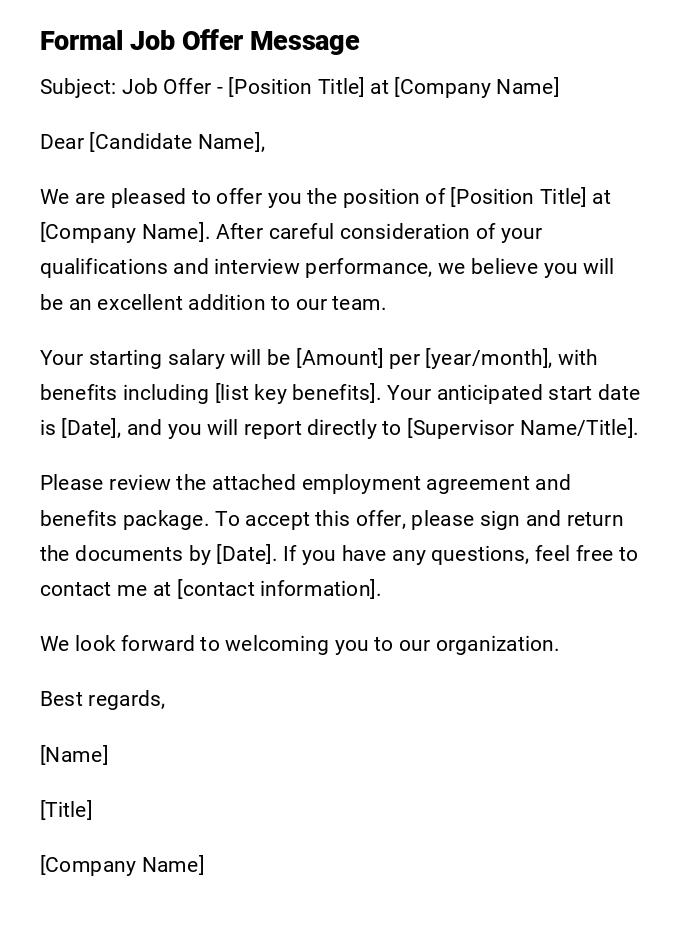
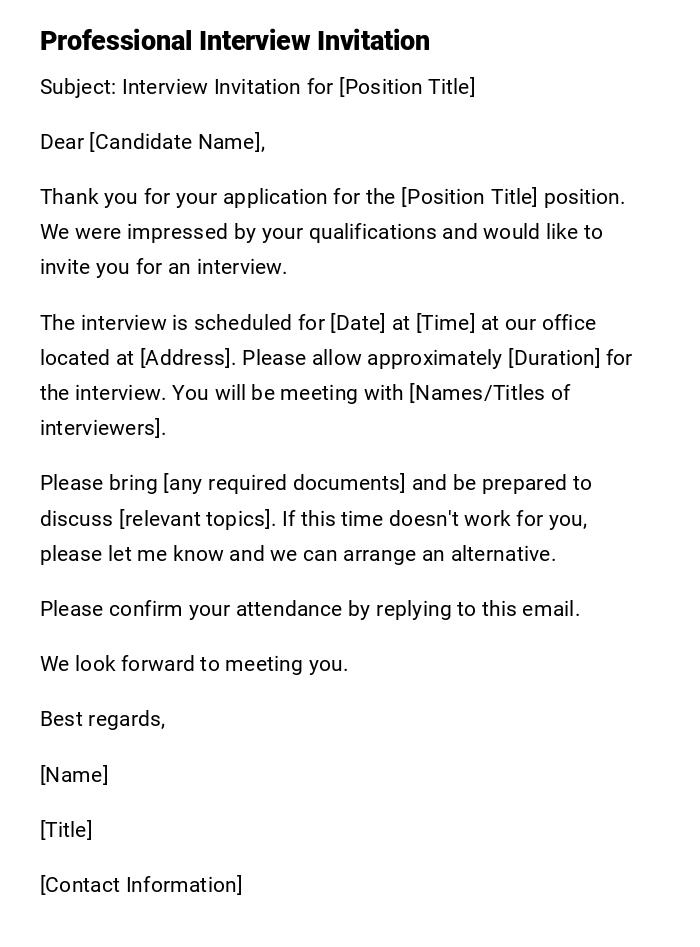
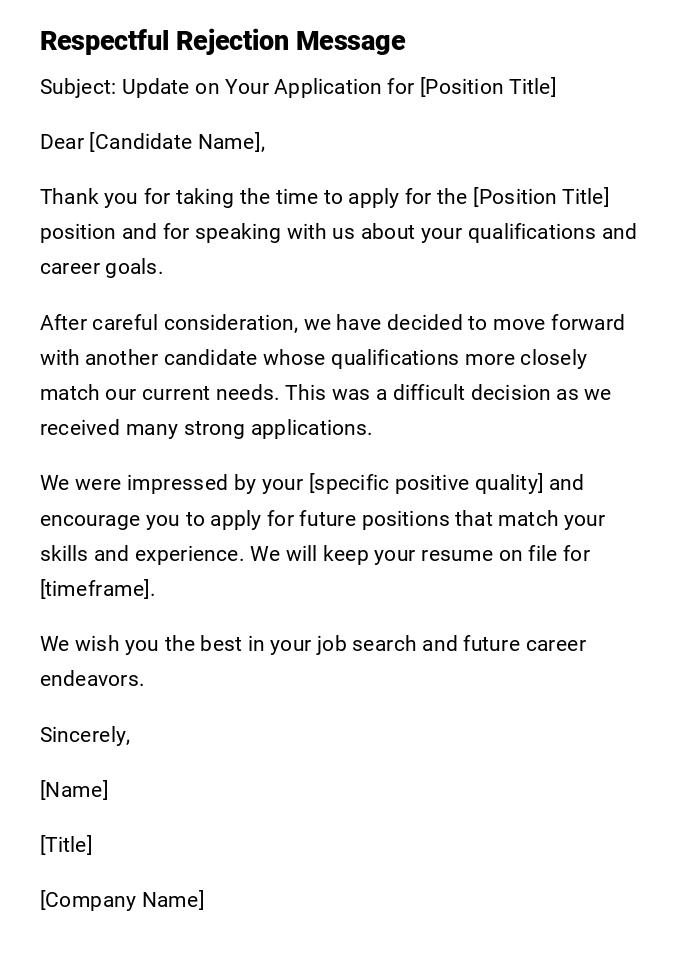
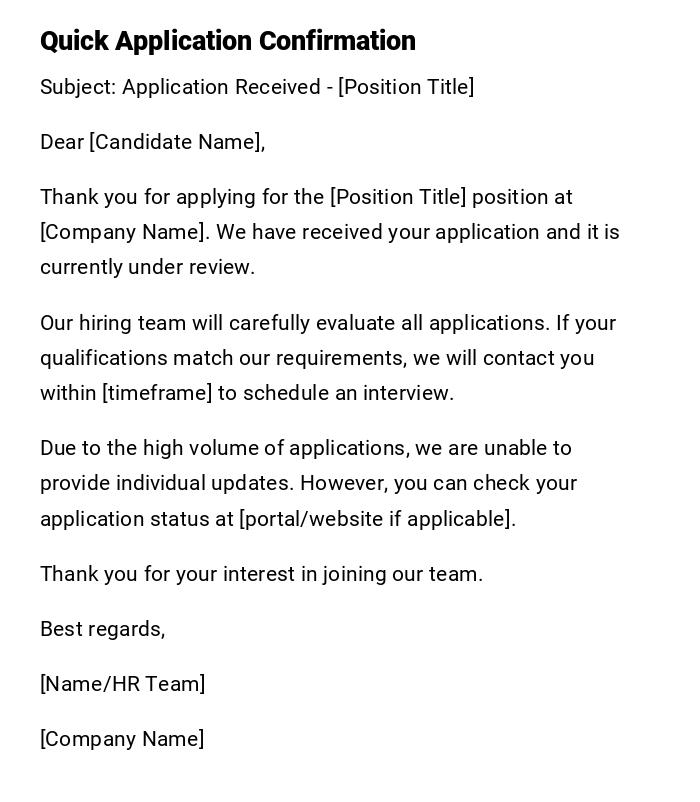
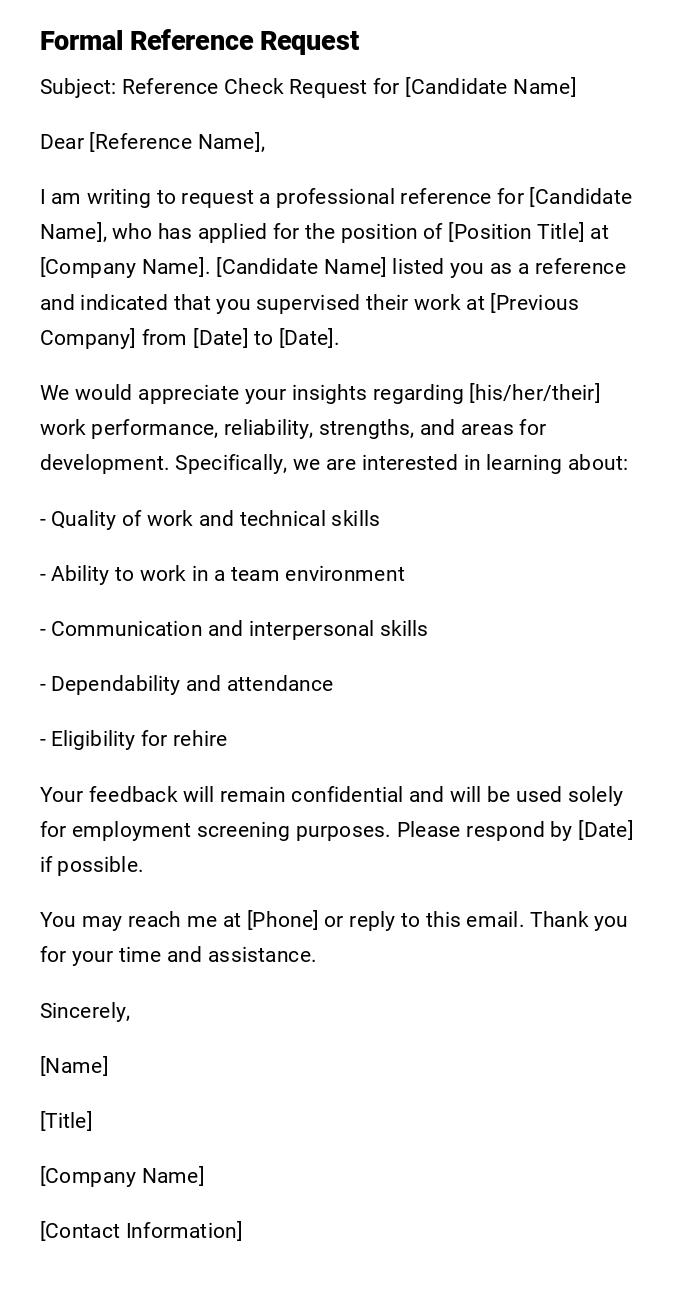
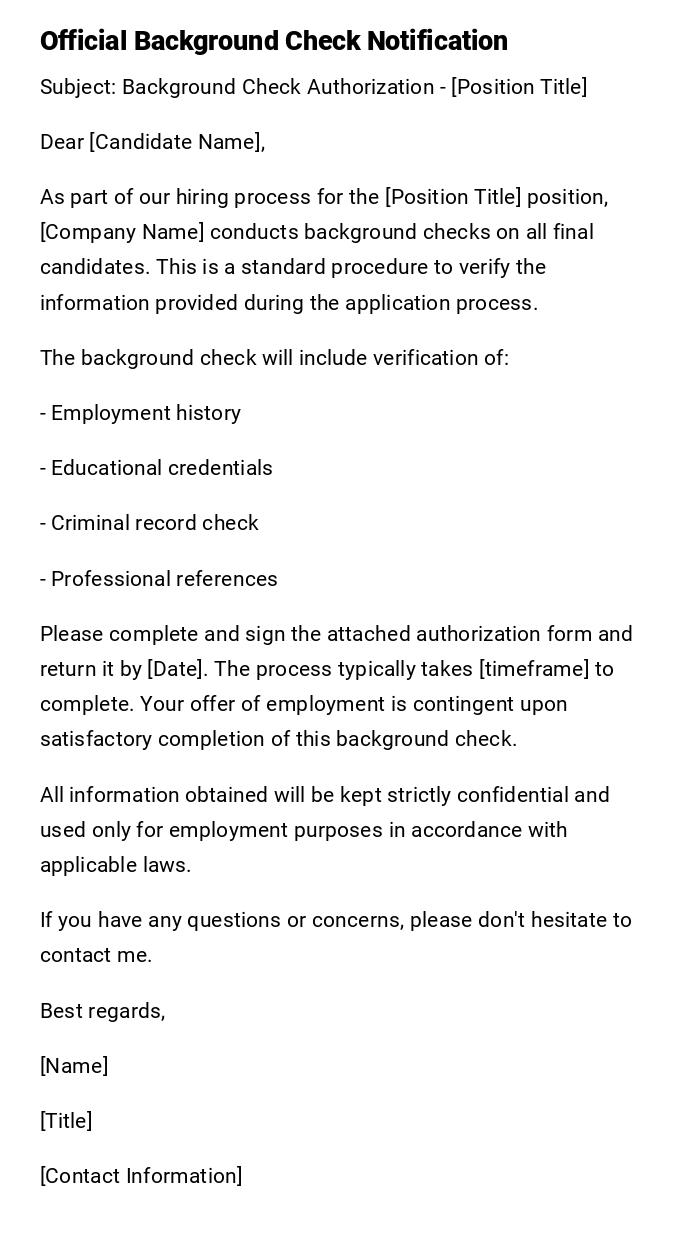
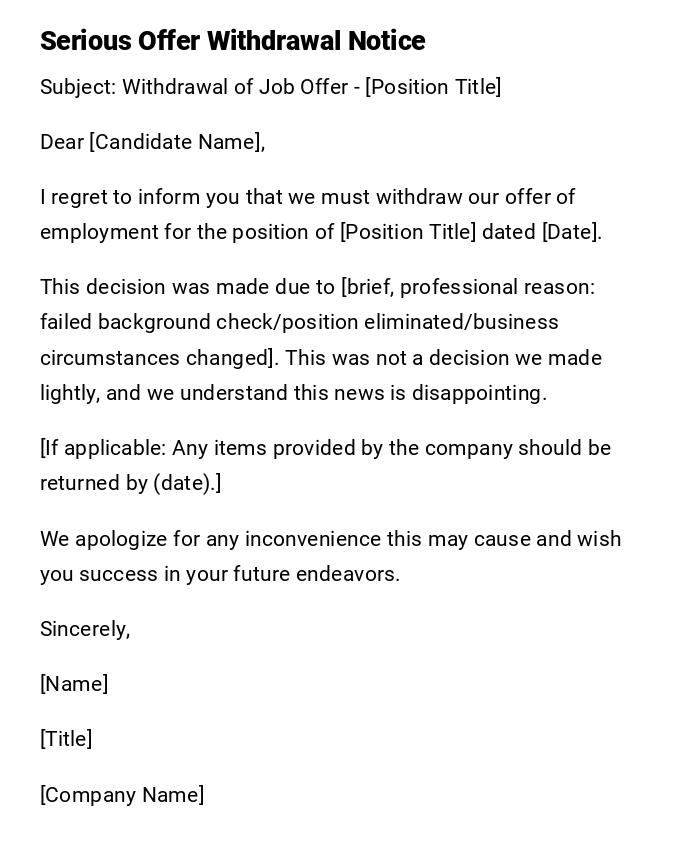
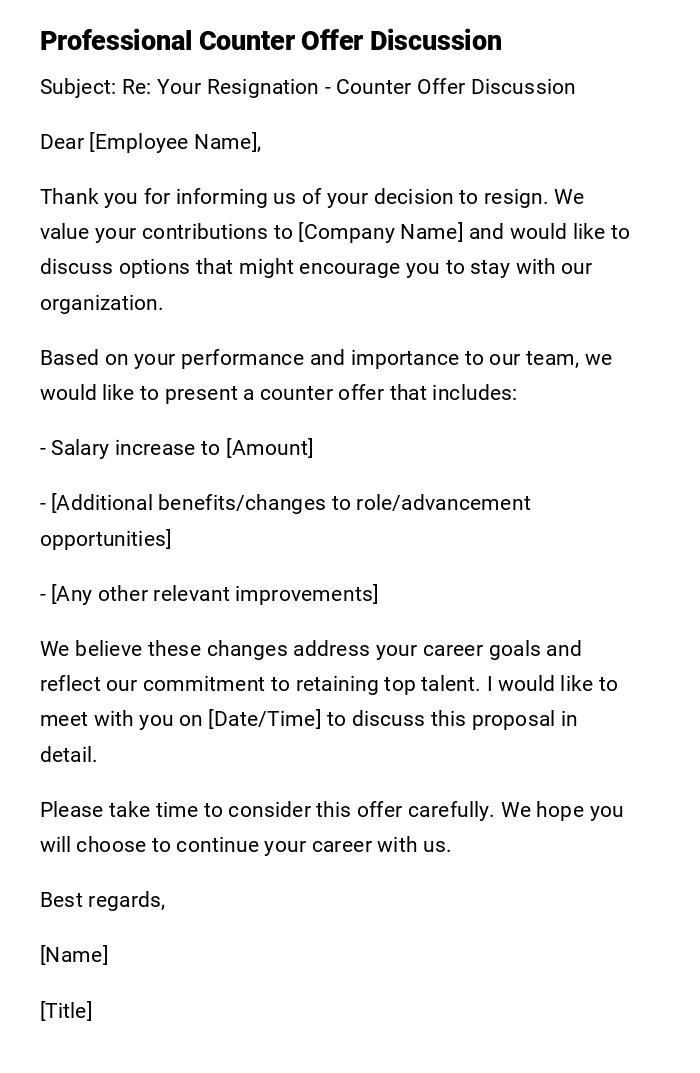

 Download Word Doc
Download Word Doc
 Download PDF
Download PDF